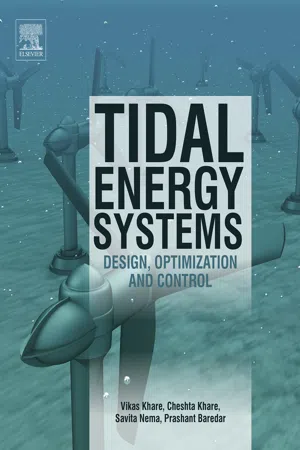
Tidal Energy Systems
Design, Optimization and Control
- 416 pages
- English
- ePUB (mobile friendly)
- Available on iOS & Android
Tidal Energy Systems
Design, Optimization and Control
About This Book
Tidal Energy Systems: Design, Optimization and Control provides a comprehensive overview of concepts, technologies, management and the control of tidal energy systems and tidal power plants. It presents the fundamentals of tidal energy, including the structure of tidal currents and turbulence. Technology, principles, components, operation, and a performance assessment of each component are also covered. Other sections consider pre-feasibility analysis methods, plant operation, maintenance and power generation, reliability assessment in terms of failure distribution, constant failure rate and the time dependent failure model. Finally, the most recent research advances and future trends are reviewed.
In addition, applicable real-life examples and a case study of India's tidal energy scenario are included. The book provides ocean energy researchers, practitioners and graduate students with all the information needed to design, deploy, manage and operate tidal energy systems. Senior undergraduate students will also find this to be a useful resource on the fundamentals of tidal energy systems and their components.
- Presents the fundamentals of tidal energy, including system components, pre-feasibility analysis, and plant management, operations and control
- Explores concepts of sustainability and a reliability analysis of tidal energy systems, as well as their economic aspects and future trends
- Covers the assessment of tidal energy systems by optimization technique and game theory
Frequently asked questions
Information
Introduction to Energy Sources
Abstract
Keywords
1.1 Energy and Its Transformation

Table of contents
- Cover image
- Title page
- Table of Contents
- Copyright
- About the Authors
- Chapter 1: Introduction to Energy Sources
- Chapter 2: Introduction of Tidal Energy
- Chapter 3: Prefeasibility Assessment of a Tidal Energy System
- Chapter 4: Optimum Sizing and Modeling of Tidal Energy Systems
- Chapter 5: Control System of Tidal Power Plant
- Chapter 6: Reliability Assessment Model
- Chapter 7: Tidal Energy Assessment and Economics
- Index